Baranof Blog & Fishing News
- Home
- Baranof News Blog
The next morning we awoke to some fairly decent weather by Southeast Alaska standards; high cloud layer around 2,000’, 5-10 knots of wind, a drizzling rain, and visibility of about 10 miles. Dad decided it was worth a look, so we packed up, bid our farewells, and taxied out to continue our journey.
With nothing to do as dad got us airborne and out over the waters surrounding Cordova, I remember marveling at how big Alaska really is. I’d grown up “in” Alaska, but had never spent an appreciable amount of time outside of Southeast. The night before we’d borrowed a truck from the local air-taxi operator (might seem weird loaning a car to a complete stranger, but he had our airplane… Again, welcome to Alaska!) and drove out to the Copper river for some sightseeing. On the road we were stopped by some oncoming traffic as a moose, towering over the cab of our Chevy Silverado, decided he had the right of way as he ambled past us without so much as a “thank-you” bob of his head. After this short delay we made our way to the river, completed our sightseeing trip, then headed back to town without further deer-delay to bed down for the evening.
My reminiscing was interrupted by a few curt words from my father. “Get the chart”, he said. (This was alarming to me in a way as, even though I was too old and experienced to admit it out loud, I was still young enough to be surprised that my father needed assistance from something so rudimentary as a map. (Next, he’d be consulting instructions to put together a Lego castle…). Peering about as I pulled out our sectional chart, I began to understand the situation. Like the children in Chitty-Chitty Bang-Bang realizing the tide had come in around their magical car as they were lost in their father’s story, the weather had deteriorated at an alarming rate around the plane I was riding in while I was lost in thought. There had been a storm in the area the last few days, and the stubborn thing was still there – visibility was down to a couple miles, the rain was driving in winds of at least 30 knots, and the seas below us were 40’ swells. Save for the swells, the conditions would not have been out of the ordinary in Ketchikan; I believe the old timers would have termed these conditions “pretty crumby”, compared to the “pretty good” conditions we’d departed in (during my day-dreaming session we’d blown right through “kinda scuzzy” and “a bit bumpy”). However, over the open ocean, with no other point of reference now that our visibility was gone and we’d since left Henderson Island behind us, my dad wanted me to find a heading from Seal Rocks to Montague island. We estimated the strength and direction of the wind by looking at the seas below us, came up with a crab angle, and continued on to Montague. Once we got there, with the conditions getting worse, dad told me to find a place to land. On our map was a small lake situated just inland from the south shore of the island. We buzzed around over the lake for a minute as dad contacted an airliner overhead on the emergency channel of 121.5. He asked them to call his wife and let her know we were going to camp for a night or two and we’d call when we got to Seward. I don’t remember the name of this lake, but I do remember, much to my indoorsman delight, that it had a Forest Service cabin. We touched down, taxied to shore, tied off the plane with every rope we had, and schlepped our gear through the trail to the cabin.
This Forest Service cabin was the same design as I was used to seeing in Southeast at places like Ella lake and Manzanita, but it was fortified like Bert from Tremors had prepped it for the apocalypse. My ignorance of moose driving habits serves as a good example as to why I hadn’t even considered the idea that the area would have brown bear wandering around… One bear in particular seemed to have the cabin lands designated as his territory; Hercules was his name, and the cabin logbook was full of accounts of him hurrying to the sound of gunshots to feed on what deer remains hunters had left behind after making their kill. We never met or saw any sign of Hercules, but my father did scare the life out of me during our second night at the cabin when he woke up and knocked over some gear on his way to the door while I was still sleeping. Bears aside, this cabin was a God-send. Some canned goods had been left behind by previous occupants. Though someone had erroneously believed mayonnaise had any kind of shelf life, the rest of the food, along with the tuna packets we had with us on the plane, served to provide us with some delicious fare. Our 3-day, 2-night, all-inclusive resort stay at the Chalet de Montague resort was an incredible bargain at $0.00 U.S. We were responsible for our own 2:00 a.m. tree-clearing, as the lake level rising a couple feet during the storm necessitated chopping down a parking space to keep our airplane from bobbing its way to a new location, but this was a minor inconvenience compared to any and all accommodation alternatives.
Once the storm passed, we loaded our gear on the plane, filled out the logbook at the cabin with tales of our travails, and took off from the by-now much larger lake. We headed to Seward, but it was socked in, so we landed in Homer. From Homer we made our way to Anchorage after fueling up, gave the plane back to the owner, and hopped on an Alaska Airlines jet back to Ketchikan – all according to plan. Compared to the rafting adventure he’d taken my brother and I on from Upper Mirror to Lower Mirror lake, things had gone surprisingly incident free by my father’s standards on this trip. But that’s a story for another time.
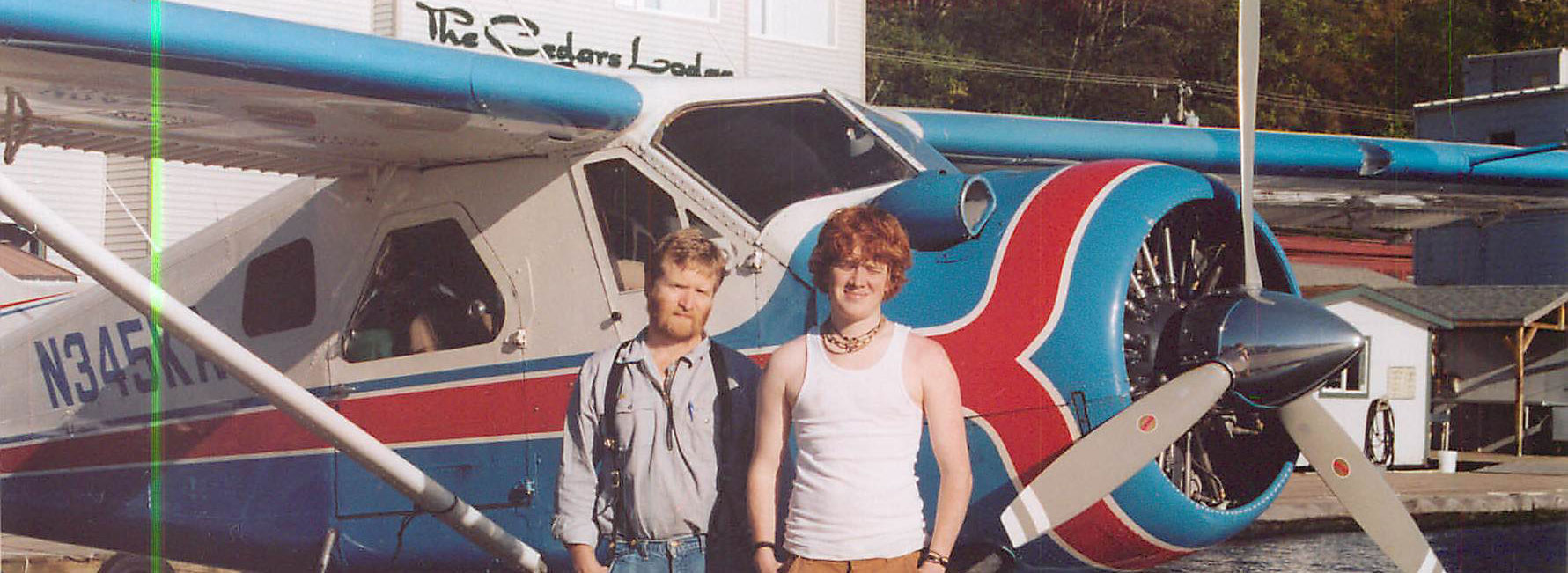
600-odd miles northwest of Ketchikan, Montague island rests at the northern reaches of the Gulf of Alaska. The island is a long and comparatively thin stretch of land with low hills, several lakes, and the rocky shores and forests common in coastal Alaska. At the end of the summer in 2002, my father and I found ourselves unplanned beneficiaries of the Forest Service as we made one of their cabins our home for three stormy days and nights. Here’s the story, as best as I can remember it, with only as much exaggeration as I think I can get away with (you are reading this on a sportfishing-centric website…).
In 2001 I graduated high school, and after a summer of working for my father as he and his brother launched Baranof Fishing Excursions, I headed off to flight school. I spent six months down in California over the next year with the family of my parents’ college friends (hands down the most wonderful group of people I know), after which I returned home. With only about 250 flight hours in my logbook, and needing a minimum of 500 to be anything close to marketable to even the smallest of airlines, I took a job as a floor-sweeper, coffee maker and general nuisance at Promech’s maintenance facility. Promech was, at the time, the largest air taxi in Ketchikan, owned by a man my father had been associates with since he was my age (17 – young, not the 35 graying years I have on me now…). The idea was I would hop on any flight I could and build time during empty legs of the company’s commuter flights, then work my way into the right-seat (co-pilot) of one of Promech’s DeHavilland Twin-Otters. The Twin-Otters were sold due to regulations that made their operation impractical following 9/11, restrictions since lifted, but the plan ultimately worked out as I was able to use the time I built and get a position in the Caribbean flying Twin-Otters on floats for Seaborne Airline. (I’m getting to the point, I promise.). During the tourist season, Promech would lease extra aircraft for Misty Fjords flightseeing tours. At the end of the season, the planes were either stored for the winter at the maintenance facility or returned to the owners. One such aircraft, an iconic DeHavilland Beaver, was leased from Ketchum Air out of Anchorage, Alaska. At the end of the season, my father offered to fly the aircraft back to Anchorage for free, as long as I was allowed to accompany him. Being an accomplished pilot and friends with the owner, Promech agreed readily. In late September, our journey began.
If you ask my father why he’s been successful, one humble brag he’ll allow is that he’s always tried to identify what might go wrong and be prepared for it. That sounds simple enough - many of us believe we have a back-up plan and don’t leave a lot to chance - but the quickest and easiest evidence I can provide of this is that he plans on two tires going flat at once during a road trip, not one. So when I say that we loaded the plane with everything we’d need for the trip, I mean we loaded the plane with everything we needed for the trip in about 5 minutes – then we spent the next 25 minutes loading it with everything we might need, things it was unlikely we’d need and items and gear we’d only need if everything went to hell. We used it all.
The plan was simple. We’d leave Ketchikan, overnight in Juneau, swing by Cordova for fuel, then shoot across the northern tip of the Gulf of Alaska (just off the coast, we weren’t planning on being out of sight of land) on our way to Lake Hood in Anchorage. From there we’d hop on an Alaska Airlines jet and be home the day after we left. The flight to Juneau was unremarkable by Southeast standards, but the next day as we headed farther north I was treated to scenery and wildlife viewing opportunities I’d never experienced before. Southeast isn’t known for sandy beaches, but for a seemingly endless stretch we were over boulder-free coastline as far as the eye could see. The weather was incredible up to this point of our adventure, which allowed us to get low over the beach for some up-close encounters with brown bear, a group of about 8 million seals that all flopped off into the water when we surprised them, and not a single human for hundreds of miles. We passed by Lituya Bay, famous for an enormous wave generated when half a mountain slide into the water and took several commercial fishing boats for a ride. As we neared Cordova, however, the weather began to deteriorate.
There is a lake near/in Cordova, the name I don’t recall, that has a seaplane dock on the western edge. My father and I landed there to stretch our legs and take a close look at the weather. The forecast was calling for a storm that was already underway in the Gulf to make its way a bit north, so we (my father really, he’s forgotten more about Alaskan bush flying than I’ll ever learn) decided to stay the night and take a look at things the next day. While dad was doing his thing and talking with a local pilot by the last name of Purvis, who ran a single-plane air service off that dock, he also got to chatting with another local pilot. This fella was in his mid-thirties maybe, older than me by a bit at any rate, and he was about to head out to check a landing strip. Bush flying in mainland Alaska is way different than in Southeast; they use balloon tires rather than floats to reach the remote locations. I’d grown up on floats, and my father knew I’d never done any of that kind of flying. He talked this dude into letting me hop in the backseat of his Piper Super Cub and go for a ride. Something like 1 in 12 of Alaskan citizens are pilots, with a great many of them cut from the same cloth as the gentleman I found myself strapped in behind (we’ll call him Captain Ahab because I don’t remember his name and it will make sense in a minute). Ahab and I taxied down the road (yes, the same road any car in town would use – welcome to Alaska) and took off in about 3 feet, as a light Super Cub doesn’t need much more room than a helicopter, and headed off… somewhere. We buzzed our way out over the town and headed over the islands to a single one in particular that Ahab had been wanting to take a look at. Again, I’d never done any of this kind of bush flying, so when he started circling I realized he was preparing to land and started looking for where I thought he’d touch down. I honestly could not see a single stretch of ground I’d have been comfortable gliding into as a last resort had my engine quit. Have you ever seen a trucker take a sharp turn, back into a loading dock or merge their way into a tight spot on the highway and marvel at how the vehicle seems to be an extension of their own body? Ahab was one with his plane; chopping the power after clearing the last few treetops, he deftly kept the right wing up over one small spruce as he touched the left wheel down, followed by the right. He paced the distance of our short landing area, made sure the ground was firm and level enough for take-off should the plane be heavier if he returned later and took a deer and, mission complete, we loaded back up for our return flight home. We started up, taxied back to the tree line, dropped all the flaps, and blasted out of there. He could tell by the smile on my face that I was having an awesome time, so we took a circuitous route home to do some beach combing; he said his wife collected the glass floats that Japanese fishermen used in their nets. Flying low, we skimmed over the beaches in a roundabout route back towards Cordova. With eyes peeled, I suddenly realized that Ahab had eaten something the night before that didn’t agree with him. He realized the same thing about me, but rounding a point of the beach we were air-combing we saw that neither of us was stuck in a plane with someone suffering gastronomical distress – it was Moby Dick. Not really - it was a humpback whale, not a sperm whale. Washed ashore, deader than disco, and reeking to high heaven was a great big sea mammal working on its tan. Ahab (see, makes sense – sort of), having already outgrown the boyish desire to poke dead animals with a stick, circled once but didn’t land. We continued on a bit, touched down on the beach (again, landing on completely undeveloped land seemed amazing to me), checked a knot of debris for glass floats but came up empty, then headed back to Cordova. I thanked Captain Ahab profusely for taking some punk kid flying with him and hurried out of the middle of the road so he could stop blocking traffic with his airplane. Dad and I spent the night in town, having decided during my side-adventure that the forecast precluded us from continuing on that day. The plan was we’d wake up early, head to Anchorage, and be home eating dinner in Ketchikan the next night. Things don’t always go as planned, however, and dinner was rice and canned tuna in a Forest Service cabin on Montague.
Check back next week for the rest of the story and how a Forest Service cabin saves a misadventure from becoming a complete disaster.
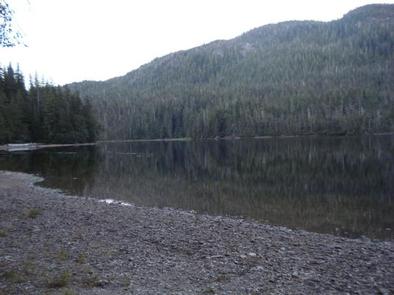
Ella lake, located in the Misty Fjords National Monument, will always be dear to me – specifically the Ella Narrows Forest Service cabin. For my 10th and 12th birthday, my mother rented the cabin for me and some friends for a few days, and my father or one of his pilots flew us out. My 12th birthday was especially memorable because my father, operating Twin-Otter seaplanes at the time, was able to pack me, my brother, our labrador Gunner, six friends and a chaperone into one plane for the 20-minute flight to the lake. The cabin is designed to hold six guests on the two single and two double bunks, but we made it work. Upon arrival, we hit the beach like we were storming Omaha and raised general hell for four days; 8 kids, a cool chaperone, bags of fireworks, and plenty of axes to go around.
All USFS cabins, at least the four or five that I’ve been to, follow the same 12 X 14’ design. Half the room is occupied by two bunks with a table in between. There is a window/refrigerator (shelves built outside the window, surrounded by a cage, allow you to keep the food you don’t want at room temperature protected from varmints but at hands-reach). One wall has shelves built along it with cupboards overhead, and there is a wood burning stove taking up the remaining space. The bunk/table situation is pretty cool as the bottom bunks are extended to provide sleeping room for two (top bunks are singles unless you’re very friendly or kind of tiny), but also double as seating for the table located between. A lot gets done in a very small space with these cabins, and if you’re willing to cram a couple people under bunks on the floor they can accommodate more than just the six sleepers they’re designed for.
To either side of the Ella Narrows cabin you’ll find, in my opinion, one of the two best sections of beach in all the world. To the East is a roughly 200’ long stretch of what Alaskans call sand, something in short supply in our area, but the beach to the West is my favorite. Although the beach is made of rocks ranging from D1 to basketball-sized, by and large, they’re weather-worn smooth, so you can navigate without shoes on and not lose any blood. Extending into the icy waters off this beach, however, is a good basketball court-sized area of shallow water. Sediment deposited from the mountain run-off has created a 2-4 foot deep area of water that warms a bit during the day. By no means “comfortable” by bathing standards, it does maintain a temperature high enough that you can play a few downs of tackle football before catching hypothermia. (Side note: there is an even larger flat like this at the inlet of Lower Mirror lake, but if you want to spend a weekend camping there you’ll need a tent.) During my 12th birthday camping trip, we spent a lot of time at this beach. There are some large dead Alder trees near the beach, so we axed a couple down and had a roaring fire going for most of our stay. This allowed us the uncommon opportunity to spend the days soaked to the bone without turning mostly blue.
Besides swimming and hewing our way through the dead Alders, we spent a lot of time playing with fire. My birthday is in June, so our trips to Ella were punctuated by the whistling of bottle rockets, the boom of artillery shells, and the frantic screams of pre-teens noticing a lit 50-pack of Blackcats arriving near their location. When we weren’t trying to blow ourselves up, we spent a lot of time seeing how large we could make our beach fires. My brother, ever the arsonist and envelope-pusher, even tried to burn down our cabin at one point. With most of us out in the boat putting around trying to catch cutthroat on the lake, I noticed a flashback toward the cabin. Once we arrived back, we noticed that Jack had decided to… mop the outside deck? Apparently, he’d been playing with some lighter fluid, scorched some supplies on the porch, and covered it up by dumping a bunch of soap and our drinking water all over the place. Compared to jumping out of a tree and puncturing an artery in his thigh with a stick, years prior, or rolling our Dad’s Land Cruiser on a pre-licensed joyride, this didn’t really even make the top-ten list of “What was he thinking?”
Forest Service cabins provide a modicum of civility to even the uncivilized. Anyone planning a trip to Alaska would be wise to consider spending a night or two in one of these rustic but comfortable chalets. They come stocked with firewood, they have a boat with oars, and they’re serviced every year by crews that ensure a safe, clean environment for you and your family to enjoy a few nights in the Alaskan wilderness. Guests can visit Tongass Trading Company for any camping gear they don’t bring with them. Many of the cabins are located on alpine lakes in the Misty Fjords National Monument, so chartering a seaplane flight from any of our air-taxi’s is recommended. Others, such as Winstanley or Alava Bay cabins can be reached via boat. Whatever your desires for a rustic getaway, the United States Forest Service has a location and cabin built just for you.
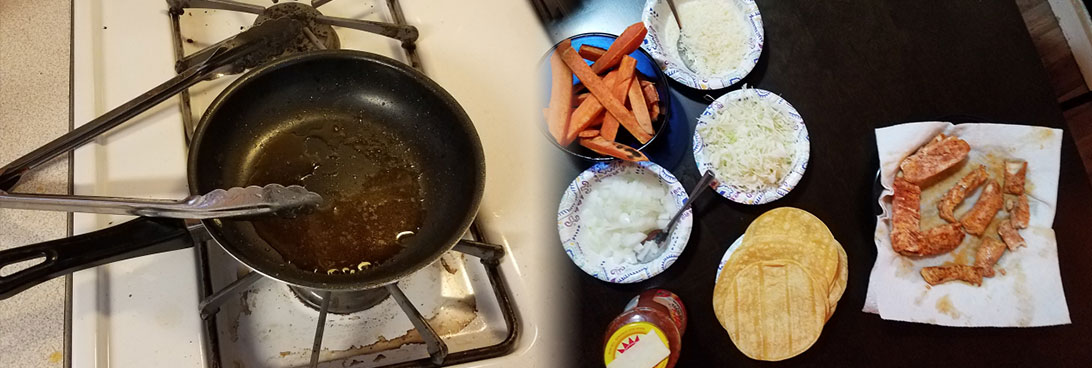
Nobody would ever describe me as passionate about cooking. Whether it’s due to my being colorblind and having a tendency to overcook things – “It LOOKS done, but better give these burgers another 20 minutes, because E.coli…”, my lack of planning – “Cordon Bleu sounds good, I bet I have everything at home, just need these breadcrumbs…”, or my predisposition towards complete laziness, I don’t spend a lot of time in the kitchen. Since my kids started growing teeth, however, necessity has truly been the mother of invention, and my forays to the grocery store have widened in scope to include more than just the freezer aisle. Mine is a culinary story of many defeats, some draws, and the occasional act of God. When I pull things out of the fridge, develop grudges against innocent ingredients, but somehow put something on the table that the kids don’t “accidentally” drop on the floor or leave my wife with a look on her face usually reserved for a Lifetime Original movie, I know my acceptance in our home is secured for at least one more day. This is the story of last night - when the light of providence bathed me and my halibut tacos in its radiant glow.
Last winter my brother took his wife and two kids camping out on some island he doesn’t remember. Before setting up on the beach for the night, they dropped a longline out in the bay. The next morning, they headed home after pulling up a couple hundred pounds of halibut from their set. (There’s a lot more to this story, but I wasn’t there and Jack (my aforementioned brother) is at work, so that’s all you get). As any good son would do, he gave our mother and her husband all the fish that wouldn’t fit in his freezer. Jump ahead a few months, and my momma is visiting me and the kids here in Missouri. For this trip, Mom and Dan (my aforementioned step-father) bought a van, loaded in a chest freezer, and ferried it to the mainland for a month of visiting grandkids. Luckily, they stopped in Missouri before heading to see Michael (my not aforementioned step-brother) and his new little girl in Colorado. Out of the chest freezer and into mine were some spot shrimp our friend Aussie Rob caught, some salmon Mom and Dan pulled out of the water, and a bunch of halibut slabs my brother and his family took from the bay of an unnamed island in Southeast Alaska. The food grown in Missouri is amazing compared to what I grew up within Ketchikan, but there is no replacement for excellent fish and the taste of home, which I’m eternally grateful my family is willing to provide. Long story short, my brother killed some fish in Alaska, my mom drove it to me in Missouri, and I fried it in a cheap pan on a dirty stovetop.
Halibut tacos are actually easier than regular tacos. When you make tacos with ground beef there is a ton of work that goes into the prep; finding a cow and turning it into ground beef, chopping onions, and finding a cooking spoon that doesn’t have holes in it can take an eternity. With halibut, you just pull it out of the freezer the morning of, slice it into portable-phone-charger sized portions, season and fry for five minutes (flipping once). Heat up some corn tortillas, layer sliced cabbage for texture (and to prevent the halibut from breaking out and escaping through the bottom of the food frisbee), grated cheese, cilantro, and lime juice, and *BOOM*, your progeny are eating food they can’t come close to appreciating. While loading up with tomatoes, onions, and other common taco complements/ingredients can be tempting and aren’t discouraged, I prefer to keep things simple when I’m dealing with my scarce supply of fish.
Yesterday, everything went according to plan. In the morning I pulled a vacuum-sealed 2 lb. filet of halibut out of the freezer and tossed it in the sink. After picking the kids up from school we headed to the local grocer for “taco stuff”. Once at the store, and with the children sent on missions of obscure product procurement, I was able to swiftly and efficiently locate pre-shredded green cabbage, paprika (I didn’t end up using it for the tacos because I forgot, but I bet it would have been awesome), chili powder, salt, little corn tortillas, peanut oil, lime juice, salsa and a brick of mozzarella. A lot of this stuff you may already have in your home, but that’s a level of adulting I haven’t reached yet. I also grabbed a sweet potato for sweet potato fries as a side. Once the kids came back from their respective missions empty-handed (“Real Mayo” is a thing, but they never find the jar of “Fake Mayo”, and 3% milk doesn’t exist) we headed home for some anxiety fueled cheffing. Everything went better than expected; I didn’t have any flour, which should have been included with the seasoning to prevent the halibut from breaking up, but the size of the fish was good enough that it didn’t segment when I fried it. The fries weren’t cooked nearly long enough, but the children probably wouldn’t have eaten them even if they had been, picky as I allow them to be… All in all, though, it was a good meal. The kids were full, the wife wasn’t fiddling idly with her ring, and I had enjoyed a dinner that reminded me of why growing up in Southeast Alaska was such a privilege.
The adventurer’s spirit is different in all of us, but at its core, it means doing something that no one, or few, have ever done before. Pulling as many strange fish out of as many different waters as possible certainly fits the bill. This article includes a bit on catching ratfish out of Ketchikan; not the main draw of the area.
https://www.sportfishingmag.com/weirdest-fish-caught-on-hook-and-line?CMPID=ene112618

Baranof Fishing Excursions is offering an Early Booking Discount for 2019 Fishing Excursions. Are you planning on Stalking Salmon while in Ketchikan? Or are you more interested in Hunting for Halibut? Have you experienced our popular Cook your Catch program? No matter what your interest is, Baranof Fishing Excursions is in the business of creating authentic Alaskan experiences for you and your family. Our fishing rates.
The 2018 season is over! Baranof and the Fish House would like to thank the crew and customers for an outstanding year.

Vote now on your favorite salmon restaurant! USA Today is asking those that know to decide which Alaskan joint puts out the best fish, and the Alaskan Fish House is on the ballot! Check it out below and let your voice be heard.
Voting ends Monday, October 15th, 2018 at 11:59 am EDT and the winners will be announced on 10Best on Friday, October 26th, 2018 at 12:00 pm EDT, then later on USA TODAY. You can read the official rules here
https://www.10best.com/awards/travel/best-salmon-in-alaska/
Southeast is known for fresh seafood. Check out this article that explores what the restaurants in our area are feeding the locals and visitors.
https://www.canadianaffair.com/blog/eat-like-local-alaska/

Our photo competition winners will win cash prizes for pictures that capture what the Fish House is all about; singing, dancing, great food, and good times. All photos will be considered (not just this weekend’s) and can be sent to Jeimi at digitalmarketing@baranof.net by September 21st. Winners will be announced with their photos displayed on our website and Facebook on September 26th.
If you missed this year's R2AK, this article by Norris Comer of NW Yachting gives one an excellent account of the trials and tribulations experienced by the teams competing in this year's engineless race from Port Townshend to Ketchikan.
https://www.nwyachting.com/2018/08/r2ak-2018-a-revolutionary-fourth/
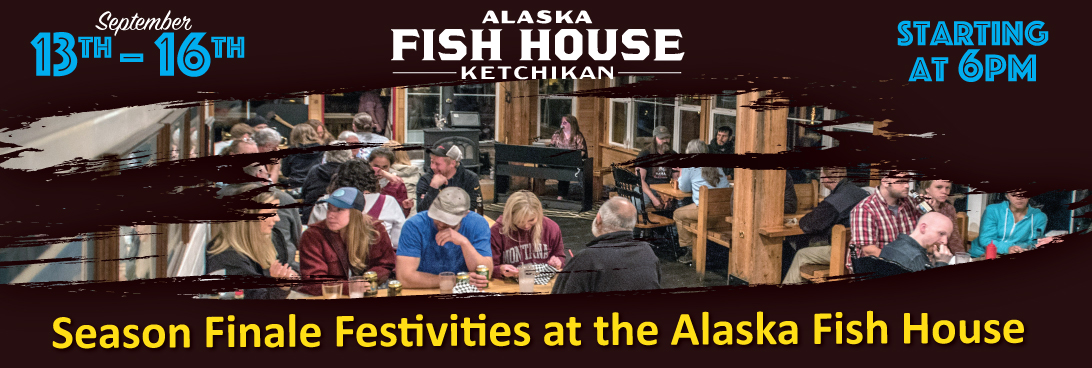
Come and join myself and the Fish House crew for four days of music and fun from the 13th-16th. Help us honor our staff for a job well done, give a special farewell to Culinary Manager Tyler Cox, and wish bon voyage to Diane Fast on her last weekend of the 2018 season. For the grand finale, come out and celebrate my birthday with our last open mic, blues, jazz, special guests, southern-style food prepared by Chef Austin and more! See you there! – Latoya
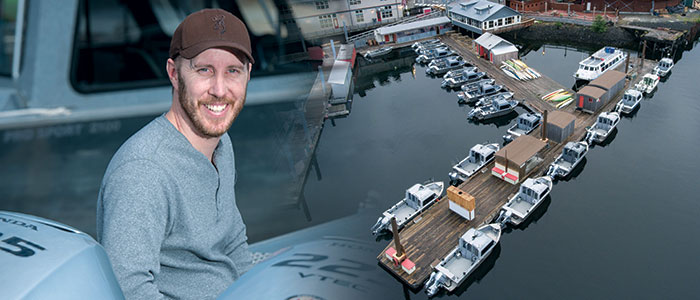
Baldwin’s duties as General Manager during the offseason have proven critical to the success of our business. While, like any good fisherman, he would rather be on the water than in an office, his passion for what Baranof offers its guests provides him with the motivation to attack all opportunities for improving the customer experience with a very personal dedication. Chris has a business degree from the University of Alaska. This means that while he is outfitting the fleet with new gear or working with Raider designing a new boat for Baranof, he is able to do so with both the customer and the company in mind; he knows what would add value for our guests, and he has the business savvy to enact those improvements in a way that keeps the owner happy. Chris is also in charge of finding, hiring, and training new captains. Many of the local sportfishing operators began guiding at Baranof Fishing Excursions, then moved on to begin their own business. We wholeheartedly support this and work closely with many of our former guides every summer, but we do need to man the vessels they’ve left behind. This year’s new recruits (Jamie, Josh, and Isaac) are a prime example of how far Chris will look to find captains that not only think of fishing every minute of the day, but also those that are passionate about providing a unique experience to their clients; there are a lot of folks out there that will work for us taking people fishing, Chris finds the kind of person that would do it for free.
Chris wears a lot of hats throughout the year and wears them well. He always has time for educating his guests, guides, and coworkers on what it means to provide the best possible experience to our guests, and proactively seeks ways to improve both his own fishing abilities and those of the company as a whole. His personal desire to exceed the expectations of his clients are perfectly inline with the goals of Baranof Fishing Excursions. We’re lucky to have him and proud to have him represent our company.
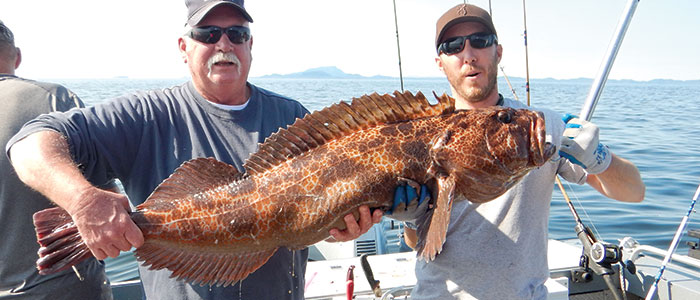
As Baranof’s Lead Guide, Chris is the perfect person to ask if you have a question on Alaska fishing. One of Chris's most marked traits is that he has an unquenchable curiosity. If Chris can't find the answer within his own personal resources, the guide pool, or friends and family in Southeast Alaska, he'll find a way to get it. He's a prolific reader when it comes to fishing, and he's always ready to listen to stories from either the old timers or one of his fellow guides because he knows he might walk away with a nugget of fishing wisdom. Because of this, he's a wonderful resource on Alaska fish and all things fishing. His administrative duties have him working closely with our Operations Manager (Andy Mikkelson) to ensure the safety of our guests while at our facility and efficient transition from the dock to the boat. He is also responsible for addressing any suggestions his guides have toward improving the overall customer experience.
As a guide, Chris has an amazing dedication to his clients; he's always focused on ensuring everybody has a successful day on the water. A typical day with Chris would have you running 45-60 minutes out to the back of Duke Island, Mary Island, or one of the other areas touched by the bordering open ocean, which often gives access to a wider variety of fish. Rock cod and lingcod are more prolific in the areas that are fed by the open ocean currents, and Chris knows it. He's always trying out new cuts for herring plugs, a different reel, or the unique technique he just picked up off the fisherman he met in Thomas Basin. Chris's willingness to experiment with bait, tackle, and different fishing techniques is one of the reasons he is one of our most consistently requested guides.
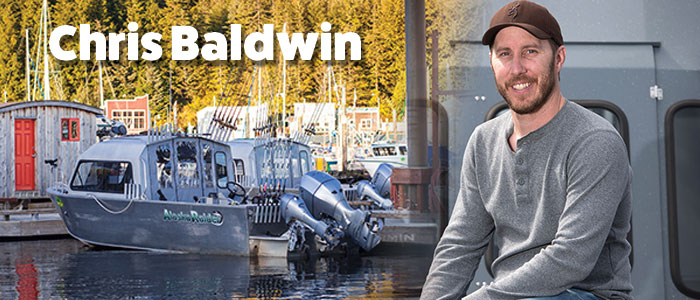
The story of Chris Baldwin is a tale of two seasons. For the first decade, Baranof’s guides were hired and managed by the owner. With his brother AJ providing expert opinion on an applicant’s abilities, Chuck was able to man the boats with experienced captains. Over time, however, our operation grew to a point where a lead guide, in charge of managing and acting as an advocate for our crew, was required to ensure a quality experience for our guests. Enter Chris Baldwin. During the summer months, you’ll find him in the thick of things, expertly managing every aspect of our aquatic and sportfishing endeavors. In the offseason, he lays the framework for the following year as general manager; while he’s difficult to keep off the water, his administrative duties are vital to improving the customer experience.
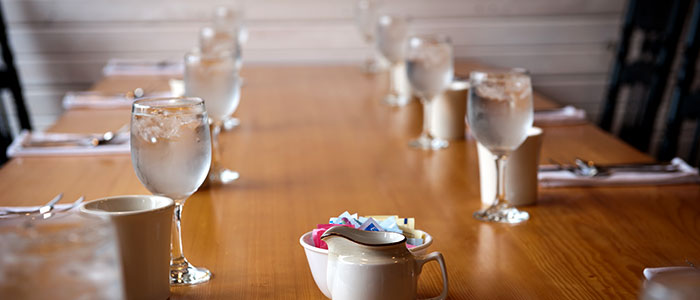
What is a chef’s table? Simply put, a chef’s table is a medium for a chef to flex his or her culinary muscle. Passionate individuals who want to share their love of food with others will offer an unforgettable dining experience where the chef decides the menu. The guests watch in amazement as a master chef transforms raw ingredients into exquisite dishes right in front of each table. As the chef takes center stage, you’ll hear the story behind each dish you are eating and learn about the thriving fishing culture of our beloved Ketchikan.
A chef’s table is meant to showcase a chef’s skill, passion, inspiration, and ingenuity. We’ve brought in chef’s from across the country who are passionate about seafood and bringing the guests a truly memorable experience. Towards that end, our chefs are intent on including the best ingredients possible. At the Alaska Fish House, this not only includes crab, shrimp, salmon, halibut, oysters, and other delicious seafood, but also more exotic and intriguing local edibles; devil’s club tip, spruce tips, ribbon kelp, seaweeds, sea cucumber, sea urchin, local berries, rhubarb, salmonberry blossoms, licorice fern, and much more. We work hand in hand with Ketchikan’s local fishermen to bring the highest quality seafood possible.
In addition to our chefs, we’ve made a very special and unprecedented addition to the culinary team this year: the forager. Think of having a rainforest as an office, where your job is to immerse yourself in nature, learning about the vast plant life of Southeast Alaska. Early each morning, one brave individual will go remote and collect the seasonal blossoms of the week to bring back to our chefs who will then create a dish, unlike anything you’ve ever seen. During low tides, our forager will suit up in raingear and take a skiff out scouring local beaches to gather edible seaweeds to be served in savory recipes created by our chefs. At the meal, the forager will be present tableside with each chef to educate each guest on locally foraged foods and sustainable practices for harvesting these plants in Southeast Alaska.
At the Alaska Fish House, our chef’s table meal will be served in a private dining room with four six-person tables, a personal chef and storyteller for each meal, and seven courses of freshly caught seafood and locally foraged, traditional Southeast Alaska ingredients. There will be plenty to eat and drink so bring along a hearty appetite. No one leaves on an empty stomach!
We’ve given our crew all the tools they need to provide an authentic Alaskan dining experience. Limited only by their imagination, we’re excited to see what kind of table our chefs prepare.
Reservations
We’ll be setting our chef’s table four times daily, with seating sold by the table. $100.00 per person, minimum of four guests with a maximum of 6. Restaurant, room, and table reservations are available.
Of special interest to locals and overnight visitors, the Alaska Fish House puts on live music starting at 8:00 on Friday and Saturday nights. Enjoy a world-class meal from 6:00-8:00 p.m., and keep date night rolling with cocktails and music next door.
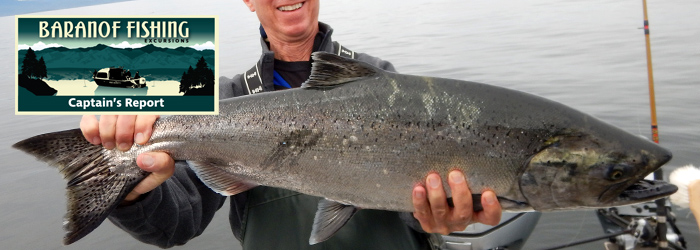
Update: King salmon sport fishing in Ketchikan opens a month early
The Alaska Department of Fish and Game just released changes to their 2018 terminal harvest area, and the relax in regulations is giving local sport fishermen a welcome sigh of relief. In 2018 the terminal harvest area has been established from Mountain Point to Carrol point where the limit will be one king salmon starting May 15th. This allows us to target and retain kings a month earlier than originally planned.
Mountain Point is roughly four miles from our dock, and while I’m sure there’ll be a whole lot of boats fishing in this area, it will be legal to keep kings 28” and over. Mountain Point has historically been a place to hold fish as they move through; given its location, it is very unlikely that Unik River kings come through the area.
The Alaska Department of Fish and Game recently released salmon regulations concerning the area around Ketchikan in which we fish. The changes are indeed historic, as these are the strictest king salmon regulations ever seen in the area. For the first time since king salmon has been protected by the state, they have closed the retention of king salmon from April 1st to June 15th. Until June 15th, king salmon will be strictly catch and release, regardless of size.
According to the ADF&G, these regulations are necessary because several runs of wild king salmon throughout Southeast Alaska are at an all-time historic low. The Unik river, in particular, is the main concern of biologists in the Ketchikan area. This river has traditionally seen the largest king salmon runs in Southern Southeast Alaska, with some runs exceeding 10,000 fish. This year biologists are expecting Unik River King salmon to number in the hundreds. These regulations are partly because the ADF&G is legally required to regulate this fishery because of a treaty with Canada.
While the news from the Unik is disappointing, hatchery fish, on the other hand, are not fairing quite so badly in our area. Southern Southeast Regional Aquaculture Association (S.S.R.A.A.) was formed and funded by commercial fishermen, and it currently operates eight hatcheries that release millions of salmon in the Southeast Alaska area every year. While several species are released, they are expecting a king salmon return which is much more optimistic than the doom and gloom of the Unik River. The travesty of the situation is that while the ADF&G is required to protect the Unik river salmon, it’s impossible to tell the difference between these wild fish and SSRAA’s hatchery fish. This creates a situation where commercial fishermen, who have invested time and money in producing these hatchery runs, are tied up at the dock because of our regulations. In 2017 king salmon news was consistently bad, with many calling it the worst year ever recorded. It was surprising that our company seemed to have its best year ever. All we can attribute it to is the lack of commercial pressure.
While it’s technically not illegal to fish for king salmon before June 15th, the fish must be released into the water; Alaska laws consider a fish brought into the boat as “retained.” This is viewed by some as ethically questionable due to the unquestionable mortality rate when playing kings close enough to pull the hooks. Needless to say, there will be no pictures of clients holding king salmon during the protection period for ethical and legal reasons. My position is, that while I would be willing to enthusiastically pursue kings before June 15th if a client had a dream of fighting a king, I’ll be recommending spending the day fishing for halibut.
There’s no way to spin this as good news for folks planning a king fishing trip in the Ketchikan area, but it’s not as bad as it may seem. While fishermen arriving within the regulated period will need to adapt their expectations, they won’t be doing it alone; please call us or email me directly if you’d like to toss around some ideas on planning your fishing charter. For those outside the restricted period, don’t be surprised if you have greater success than your friend did last year.
https://www.adfg.alaska.gov/sf/EONR/index.cfm?ADFG=region.NR&Year=2018&NRID=2534
https://ssraa.org
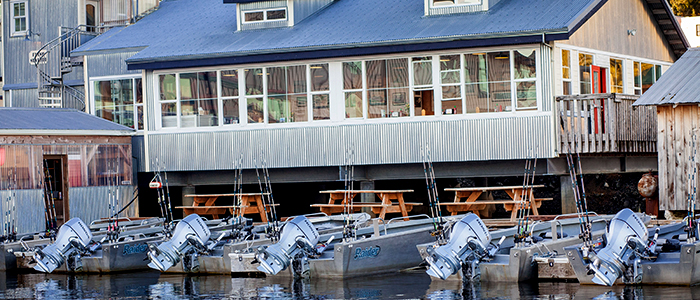
Service - We’re in the business of exceeding expectations, and that starts with the first phone call. When you ring our number, you’ll be talking to a human. When our guests have a question, you’ll be talking to an expert (or Greg); we endeavor to put you in contact with the authority on whichever topic you need more information on - be it fishing, cooking, or just Alaska travel in general. Anything less than a 5-star experience is a cause of concern for us, and we encourage our guests to make their needs known. As we identify areas for improvement, especially in the case of skewed expectations, we strive to address those issues via our website.
Baranof Fishing Excursions and the Alaska Fish House are driven to provide the most authentic Alaskan experience possible to our guests and visitors. With our commitment to continuous improvement, we’re constantly seeking ways to enhance that experience whenever possible, which is the motivating force behind our web design efforts. As we continue to expand on our site, we look forward to offering current, exciting content to visitors and locals alike, prepare future explorers for their journey to Alaska, and provide a medium to share that experience with their friends and family.
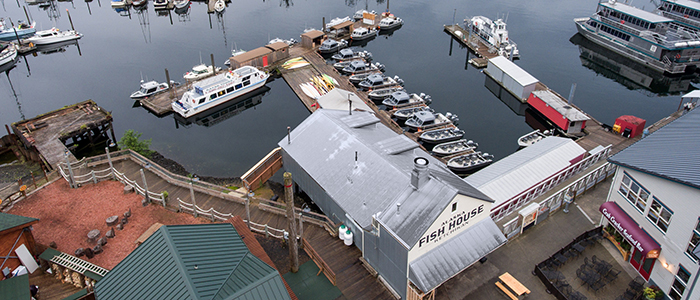
Graphics - Throughout the site, you'll see all manner of graphic content. Whether using photos sent in by a satisfied client has taken on their phone, historical photos supplied by Ketchikan Museums, or drone shots by Charley Starr, our Director of Digital Marketing, Jeimi Woffinden (who wished to remain nameless) has done an absolutely outstanding job of pairing content with pictorial representation. Our guides are provided with company cameras and are expected to snapshots throughout each one of their charters and excursions, leaving the guests to focus on their Ketchikan salmon or halibut fishing experience, which are then uploaded to our site for clients to download or link to their friends.
Analytics - Anything measured tends to improve. Towards that end, we use a number of different programs to track the customer experience on our site. By keeping a sharp eye on Alexa and Google rankings, bounce rate, and where visitors spend their time, we are able to identify areas that need to be improved or expanded upon. While that may seem Big Brother-ish, it’s all for a good cause; knowing, for instance, that folks are spending time reading our blog, checking out our recipes, or amusing themselves by perusing our Alaskan Anecdotes stories enables us to focus on what our visitors value most.

Baranof's website has undergone some dramatic changes over the last year or so. Our owner, Chuck Slagle, no longer believes computers, or even the internet, are just fads. He decided to invest a wealth of time and funding towards retooling the company web page by hiring and contracting proven and talented individuals to provide excellent graphics, content, and analytic overview. Our mission is to provide an informative, interactive experience for prospective clients, tell stories that our guests can live, and offer insightful recommendations on how to best enjoy Ketchikan. Here's how we do it...
Connections - Most of the people you meet in Ketchikan, and the rest of Alaska, are here because they can’t imagine living anywhere else. Baranof, as well as most every other excursion company you’ll come across here, is made up of these individuals. We are constantly seeking connections through our site with the companies we feel exemplify Baranof’s passion for providing authentic Alaskan experiences. Our Explore Ketchikan section provides ideas for recommended activities, restaurants, excursions, and anything else we believe to be integral to what makes Ketchikan a wonderful place to live.
Storytelling - Baranof is about providing experiences, which manifest later as stories told by our guests to their family and friends. That being the case, a question we constantly ask ourselves when diving into a new project or looking to connect with another Ketchikan business is "What's the story here?” The focus of the web team is to tell good stories. Oftentimes, folks hop on a cruise ship or plane and travel to Alaska with expectations lower than they should be. Spinning a good yarn excites the imagination and educates our guests on what they can, and should, expect from their vacation in Alaska. For example, Ketchikan is known for salmon fishing, which is an excursion Baranof is proud to provide, but some folks get up here without realizing our main attraction is the amazing scenery found all around, especially in the Misty Fjords. We want our visitors to dream big, aim high, and leave Alaska having checked boxes off their list that they didn’t even know existed. We encourage our clients to tell us what their story of Alaska sounds like before they come up and let us figure out how to make that story come true.
From the Wheelhouse
Our captain’s report on up-to-date fishing conditions, regulations, and trends.
View Report
Check Back For These Great Upcoming Stories
- Overnight kayaking through the Mistys Fjords
Nothing breaks you into the beauties of the Misty's like a week paddling through her splendor. - SE Alaska 2019 Fishing Regulations
Fishing limits and the Fish & Game’s reasoning, and what it means for Baranof’s guests. - Adventure around Revillagigedo Island
Misty's, Hot Springs, Fishing, Crabbing, and wildlife; the experience of a lifetime.
- February 2024
- April 2023
- June 2022
- March 2021
- February 2021
- March 2020
- February 2020
- January 2020
- December 2019
- October 2019
- August 2019
- June 2019
- April 2019
- February 2019
- January 2019
- November 2018
- October 2018
- September 2018
- June 2018
- May 2018
- April 2018
- March 2018
- February 2018
- January 2018
- December 2017
- November 2017
- September 2017
- August 2017
- July 2017
- June 2017
- May 2017
- April 2017
- March 2017
- February 2017
- January 2017